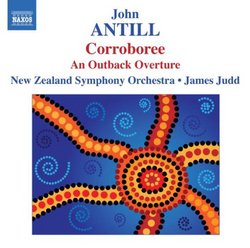| All Artists: John Antill, New Zealand Symphony Orchestr Title: Antill: Corroboree Members Wishing: 0 Total Copies: 0 Label: Naxos Original Release Date: 1/1/2008 Re-Release Date: 7/29/2008 Genre: Classical Styles: Ballets & Dances, Ballets, Historical Periods, Modern, 20th, & 21st Century, Symphonies Number of Discs: 1 SwapaCD Credits: 1 UPC: 747313024179 |
Search - John Antill, New Zealand Symphony Orchestr :: Antill: Corroboree
CD DetailsSimilar CDs
|
CD ReviewsHooray for Corroboree Avrohom Leichtling | Monsey, NY | 08/08/2008 (5 out of 5 stars) "I first encountered John Antill's ballet Corroboree in 1958 when a suite of excerpts from the complete score had been recorded by Sir Eugene Goosens and the London Symphony Orchestra. That famous Everest Recording (SDBR-3003) was not only a spectacular sonic event in and of itself, but gave exposure to one of Australia's major composers to US and European audiences. Written during the years 1936-1944, the ballet was given its first full production by the Sydney Symphony Orchestra and National Theater Ballet on 3 July 1950 conducted by the composer. The score of the work was published by the Australian branch of the British publisher Boosey and Hawkes in 1953. Antill's score was available for sale then and in 1963 I acquired a copy of it and spent much time happily going through its 209 pages in minute detail. As of this writing (August, 2008) it is no longer in print. The Everest recording presented about 25 minutes of the score which, according to Antill's own careful notations of durations, takes about 44 minutes in total performance time. Some of the interior sections of the score (in Goosens' version) were played complete, others, like the opening "Welcome Ceremony" and the final "Procession of the Totems" were horribly cut. Others were cut out altogether or abridged. The score of Corroboree has frequently been called the "Australian Sacre du Printemps" - a comparison that is both inaccurate as it is inappropriate. Stravinsky and Antill have little in common, least of all their connections to definable if stylized ethnomusical primitivism. Stravinsky's scenario for his ballet is as wholly imaginary as his music has absolutely nothing to do with an imagined "ancient" music. Indeed, its rhythmic and harmonic complexities put it squarely in the 20th century even if some of its melodies derive more spiritually from Russian folksong and Russian Orthodox liturgical chant, something he would have learned directly from his teacher Nikolai Rimsky-Korsakov. Antill, however, was a first hand witness and life long student (so to say) of the aboriginal ceremonies he used as a basis for his ballet - and there are those who have stated that the work is a remarkably accurate stylized representation of the Corroboree ceremony. The liner notes which talk of Stravinskian rhythmic complexity are way off the mark. True enough there are whole sections in 7/8 meter, or in 5/4 or other "non-western" units- but Antill's many layered and syncopated ostinatos are in no way related to Stravinsky's use of either. Stravinsky revels in constantly shifting meters whereas Antill sticks doggedly to his 3, 4, 5, 6 or 7 beat meters using them for their more ethnomusically accurate representations of real, live aboriginal music. And so, having waited 50 years for a complete recording of the score, and after having pleaded, unsuccessfully, with the Australian Broadcasting System and the Australian Music Center to release what was probably then the only complete recording of the score, it was joyful indeed to hear Naxos' new recording of the work complete and uncut. The New Zealand Symphony Orchestra must earn kudos for its spectacular playing which is utterly hair raising in places. Edward Judd should also be congratulated for having finally brought this score to a sonically superior rendering. The recorded values are crystal clear. The orchestra is miked exactly as it should be - clean and without tubbiness and detail killing "resonance" or "big hall ambient reverberation." Given the importance of this recording, there are a handful of nits that have to be picked precisely because of its importance. Some some of these are quite serious indeed. First, the pauses between the various sections of the work are interminably long - thus destroying the continuity of the music. Granted, in a fully staged performance, there might well be sections choreographed in silence - but in a recorded performance of the music, such pauses are unnecessary. Second, although comparing the timings of the recording to Antill's directions in the score, the impression might be made that the recording is spot on accurate. The truth, however, is that Judd's tempos are often way too fast - thus adding an element of hyperventilation that the score does not need. There are places where marked increases in tempo are actually slower than preceding tempos, which has the effect of making a hash out of the composer's carefully worked out directions. The added length of the trailing silences subtracted from the actual performance time of the individual sections tells the tale. One of the two places of relative relaxtion (i.e. The Morning Star) comes off sounding like an unintentional scherzo. The bass clarinet plays with very marked staccato when nothing of the kind is indicated - and this together with the wrong tempo completely destroys the effect intended. The finale is at least a full three minutes shorter than Antill's marking due to its inaccurate tempo. Three minutes in a faster than indicated tempo significantly alters the cumulative effect rendering the music breathless when it should be overpowering. Third, whatever happened to the VIBRATO (i.e. tremolo) in the VIBRAPHONE? This instrument is featured prominently in #3 (A Rain Dance), and the dead flat sound makes the instrument sound like nothing more than a bass glockenspiel on steroids. The characteristic amplitude modulation is completely absent. There are also fistfuls of wrong notes in the piano, especially in #5 (The Rising Sun) which could easily have been avoided with a more reasonable tempo overall. The liner notes to the recording are decent insofar as biographical and historical matters are concerned. Stop reading them, however, when it comes to descriptions of the music since they are wrong. Even Naxos's blurb, which is slavishly reproduced by all the various record retail outlets, quite misses the mark, especially in describing Antill's Outback Overture which is anything BUT Stravinskian or Coplandesque or British for that matter. If Antill is spiritually close to any other composer, it would have to be Charles Ives. Antill's pastiche-like assemblage of bits and pieces has all the earmarks of an Ivesian mentality and intent absent Ives' often unfathomably complex metrical elements. And if British in any way, it is closer to the Malcolm Arnold of the Tam O'Shanter Overture written in 1955, a year after Antill's piece. All in all, however, overlooking some serious interpretive problems and flat out inaccuracies, this is an important recording of a major work by one of Australia's major composers. In listening to this score, it would be a good idea to have Goosen's 1958 recording handy for comparison." An Exuberant Ballet D. A Wend | Buffalo Grove, IL USA | 02/03/2010 (5 out of 5 stars) "John Antill was born in Australia of English parents. His musical talents were recognized early and he won a scholarship to study composition. The Outback Overture was written in 1954 and is a marvelous piece program as a concert opener. One can detect the influence of Percy Grainger in the good-humored patriotic tone of the music. Corroboree is an earlier work from 1946 and was written as a ballet. The name is an Anglicized version of an Aboriginal word (Caribberie) which is used to describe their ceremonies accompanying their Dream stories. The stories concern the journeys of ancestors and their interaction with the natural world. Antill attended one of the ceremonies and his music draws on Aboriginal music that he noted. The music has a "primitive" sound coming from many of the unusual percussion instruments used in the work and the mimicking of nature sounds, such as birdcalls. Perhaps the most interesting is a bull-roar that is used in the last section. The brass, in particular, are used to create an uproarious effect. After the opening section, come short dance sequences. The first, titled Dance to the Evening Star is scored for oboe and celesta. The Rain Dance makes use of a xylophone and flute contrasting with the full orchestra. Percussion is highly featured with a rhythmical dance in the Spirit of the Wind. The Rising Sun has a variety of percussion joined by a piano and the full orchestra in a fast-paced music journey. The shortest piece, The Morning Star, makes use of bassoons and clarinet evoking various animals. The longest section is the Procession of the Totems and Closing Ceremony. Many of the prior melodies are restated and developed and the work ends with a blaze of brass. James Judd does a fantastic job of bringing Mr. Antill's music to life and the New Zealand Symphony Orchestra demonstrated that they are a first class orchestra. If you are interested in exotic music this disc should join your collection. " A superb disc G.D. | Norway | 09/21/2009 (5 out of 5 stars) "If anyone were ever really a one-hit wonder among composers, then John Antill (1904-1986) was. Corroboree is perhaps best known as a concert suite, but real credit is due to Naxos for giving us the complete ballet - a thoroughly excellent and engaging work. The work was (as a concert suite) first performed in 1946, and Antill attempted to evoke the atmosphere and ritual of the aboriginal music of his homeland. The result is perhaps more or less entirely Western, despite the inclusion of unconventional effects to the orchestration, but the work is still pretty remarkable with spectacular climaxes, propulsive motivic developments and hammering rhythms - much use of ostinato - with atmospheric respites (especially the notable influences of jazz creates striking effects). One cannot avoid comparisons with Stravinsky's Rite, but similarities are superficial (rhythmically pungent and primitivistic depiction of an aboriginal ritual); Corroboree is an entirely self-sufficient, individual work of real stature. Listen once to the climax of the final movement, for instance - a mad frenzy emphasized by hammering percussion and the wailing of the bull-roarer - and I guarantee you that you've never heard anything really like it.
Antill was aware, however, of the danger that he might end up just re-composing Corroboree if he continued in the same vein, and consequently the work is something of a stand-alone in his output. The rest of his music consists mostly of accessible music in early 20th century style, much influenced by the English choral tradition; often engaging and enjoyable (apparently), but slightly anonymous. The coupling on this disc, An Outback Overture, is a decent example - a fine, tuneful and well-crafted work, far removed from the dazzling modernism of Corroboree but pleasing enough. The performances sound utterly committed and involved - they must surely have relished the work as much as this listener did - and they surely have the technical skills to bring it off. This is, in short, excellent playing of a hugely enjoyable score and a real feather in the cap for Naxos. The only real complaint one could possibly have would be the slightly stingy playing time. Still, I won't hesitate to claim that this disc is something of a must-have." |





